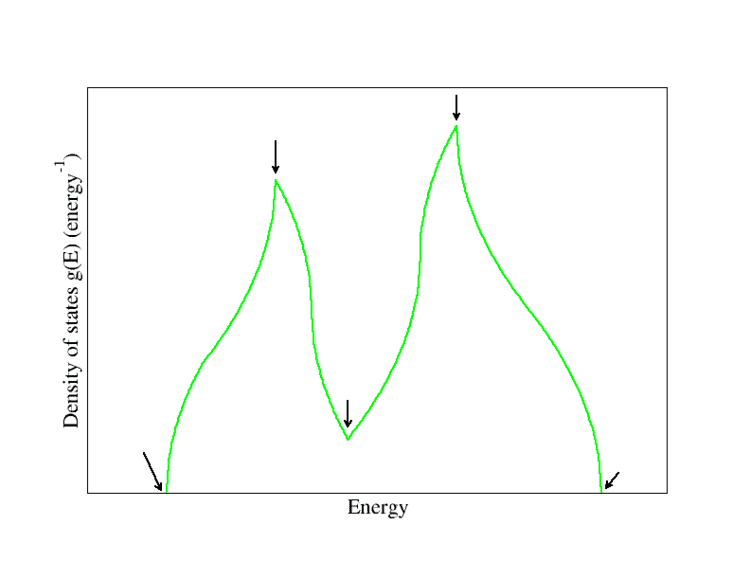 | ||
A Van Hove singularity is a singularity (non-smooth point) in the density of states (DOS) of a crystalline solid. The wavevectors at which Van Hove singularities occur are often referred to as critical points of the Brillouin zone. (The critical point found in phase diagrams is a completely separate phenomenon). For three-dimensional crystals, they take the form of kinks (where the density of states is not differentiable). The most common application of the Van Hove singularity concept comes in the analysis of optical absorption spectra. The occurrence of such singularities was first analyzed by the Belgian physicist Léon Van Hove in 1953 for the case of phonon densities of states.
Contents
Theory
Consider a one-dimensional lattice of N particle sites, with each particle site separated by distance a, for a total length of L = Na. Instead of assuming that the waves in this one-dimensional box are standing waves, it is more convenient to adopt periodic boundary conditions:
where
Extending the analysis to wavevectors in three dimensions the density of states in a box will be
where
where
The set of points in k-space which correspond to a particular energy E form a surface in k-space, and the gradient of E will be a vector perpendicular to this surface at every point. The density of states as a function of this energy E is:
where the integral is over the surface
We can then write dE as:
and, substituting into the expression for g(E) we have:
where the
A detailed analysis shows that there are four types of Van Hove singularities in three-dimensional space, depending on whether the band structure goes through a local maximum, a local minimum or a saddle point. In three dimensions, the DOS itself is not divergent although its derivative is. The function g(E) tends to have square-root singularities (see the Figure) since for a spherical free electron Fermi surface
In two dimensions the DOS is logarithmically divergent at a saddle point and in one dimension the DOS itself is infinite where
Experimental observation
The optical absorption spectrum of a solid is most straightforwardly calculated from the electronic band structure using Fermi's Golden Rule where the relevant matrix element to be evaluated is the dipole operator
The divergences in the two- and one-dimensional DOS might be expected to be a mathematical formality, but in fact they are readily observable. Highly anisotropic solids like graphite (quasi-2D) and Bechgaard salts (quasi-1D) show anomalies in spectroscopic measurements that are attributable to the Van Hove singularities. Van Hove singularities play a significant role in understanding optical intensities in single-walled carbon nanotubes (SWNTs) which are also quasi-1D systems. The Dirac point in graphene is a Van-Hove singularity that can be seen directly as a peak in electrical resistance, when the graphene is charge-neutral. Twisted graphene layers also show pronounced Van-Hove singularities in the DOS due to the interlayer coupling.
